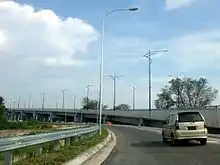Klang Third Bridge
The Klang Third Bridge, also known as Jambatan Ketiga Klang (Jambatan Ke-3 Klang) is a modern engineering infrastructure in royal town of Klang in the state of Selangor, Malaysia. Built at a cost of RM230 million, the Klang Third Bridge complements the two existing bridges in Klang, namely the Kota Bridge and the Musaeddin (Tengku Kelana) Bridge.[1] All three bridges cut across the Klang River, connecting the northern and southern parts of Klang.
Klang Third Bridge Jambatan Ketiga Klang | |
|---|---|
| Carries | Motor vehicles |
| Crosses | Klang River |
| Official name | Jambatan Raja Muda Nala |
| Maintained by | Klang Municipal Council (MPK) |
| Characteristics | |
| Design | Balanced cantilever box girder |
| Total length | 2,525 meters |
| Width | 4-lane carriageway |
| Longest span | 1,200 meters |
| History | |
| Designer | Malaysian Public Works Department (JKR) |
| Constructed by | Cergas Murni Sdn Bhd |
| Opened | 2017 |
.jpg.webp)
_towards_the_north_(Jalan_Goh_Hock_Huat).jpg.webp)

_towards_Jalan_Goh_Hock_Huat_and_Kapar.jpg.webp)
On 24 May 2017, the Klang Third Bridge was opened for traffic.[2]
On 19 Nov 2017, The Sultan of Selangor, Sultan Sharafuddin Idris Shah officially opened the Klang Third Bridge which was built at a cost of RM199 million and named it Jambatan Raja Muda Nala (Raja Muda Nala Bridge). Raja Muda Nala was the eldest son of the first Sultan of Selangor, Sultan Sallehuddin Shah.[3]
History
The Klang Third Bridge project was first mooted in early 2008. Based on the state Public Works Department survey, about 43,000 vehicles used the Musaeddin (Tengku Kelana) Bridge whilst 150,000 vehicles ply the Kota Bridge daily. With the increasing traffic, there was a dire need to construct the third bridge for Klang.[4]
A ground-breaking ceremony of the bridge project was officiated on 4 March 2008 jointly by then Selangor Menteri Besar Datuk Seri Dr Mohd Khir Toyo and Malaysian former works minister Datuk Seri S. Samy Vellu. However, the project did not take off as it was interrupted by a change of the state government following the general election which saw the collapse of the Barisan Nasional state government in Selangor.[5]
In 2014, the bridge project was resurrected when former Selangor Menteri Besar Tan Sri Khalid Ibrahim announced that the Pakatan Harapan state government had set aside RM300 million for the construction of the Klang Third Bridge. The completion of the bridge was delayed twice due to technical problems in land acquisition, relocation of a nearby temple and also the construction of a government health clinic.[6]
On 1 April 2020, Klang Third Bridge was closed to reduce people’s movement as part of the enforcement of the Malaysian movement control order (MCO).[7] It was then reopened on 4 May 2020 after the Malaysian Government eased MCO restrictions under a Conditional MCO (CMCO), which allowed certain business sectors to resume operations.[8]
Features and connectivity
The Klang Third Bridge was constructed using the sophisticated balanced cantilever box girder technology, and the project was being carried out by Syarikat Cergas Murni Sdn. Bhd. through an open tender system with the contract value of RM199 million, under the close supervision of the state Public Works Department (JKR). The cantilever bridge with four-lane carriageway spans 1,200 meters with an elevation of 150 meters above the Klang River, with a total length of 2,525 meters connected to a 3.8km upgraded roads on both sides of the bridge.[9]
The 1.2km-long bridge connects the northern and southern parts of Klang through Jalan Goh Hock Huat and Jalan Sungai Bertih respectively.[10] The bridge is aimed to facilitate traffic between Klang north (Kapar, Meru, Federal Highway, NKVE) and Klang south (Port Klang, Bandar Bukit Tinggi, Bandar Botanic, KESAS, SKVE), hence re-routing the traffic from entering the Klang town centre.[11] It is expected that over 60,000 vehicles will use the bridge daily, reaching its full capacity of 120,000 vehicles daily by the year 2032.[12][13]
Gallery
.jpg.webp) Traffic intersection at Jalan Goh Hock Huat leading to the Klang third bridge (north side)
Traffic intersection at Jalan Goh Hock Huat leading to the Klang third bridge (north side)_towards_the_south_(Jalan_Sungai_Bertih).jpg.webp) Entrance to the Klang third bridge from the north (Jalan Goh Hock Huat) towards Klang south
Entrance to the Klang third bridge from the north (Jalan Goh Hock Huat) towards Klang south.jpg.webp) On the Klang third bridge (Klang river on the left, Klang town at the background)
On the Klang third bridge (Klang river on the left, Klang town at the background).jpg.webp) On the Klang third bridge (Klang river on the right)
On the Klang third bridge (Klang river on the right)
References
- "RM230m third Klang Bridge to be ready by mid-2017, Azmin says". The Malay Mail.
- "Klang's third bridge opens". The Star, Malaysia.
- "Sultan of Selangor opens Klang Third Bridge". The Sun Daily.
- "Jambatan Ketiga Klang Kurangkan 20% Kesesakan, Siap Julai 2016". Malaysian Digest.
- "Klang's third bridge to be ready by year end". The Star, Malaysia.
- "Klang's third bridge to open by March". The Star, Malaysia.
- "Two bridges in Klang to be closed to traffic as part of MCO". The Star, Malaysia.
- Tho, Xi Yi (10 May 2020). "Malaysia's movement control order to be extended further until Jun 9, says PM Muhyiddin". Channel News Asia. Archived from the original on 10 May 2020. Retrieved 10 May 2020.
- "Jambatan Ketiga Klang: Teknologi tanpa tiang, atasi aliran trafik". Selangorkini.
- "Klang Bridge Faces Delay". Property Guru Malaysia.
- "Klang's third bridge ready". The Star, Malaysia.
- "Jambatan Ketiga Klang siap 2016" (PDF). Works Ministry, Malaysia.
- "First phase of Klang third bridge to be completed in July 2016". The New Straits Times, Malaysia.